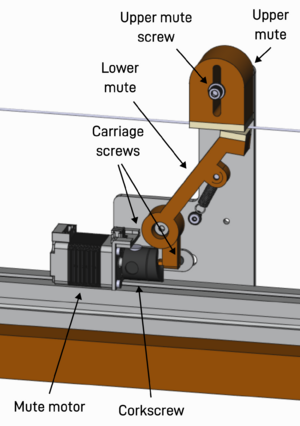The Ekdahl FAR - Mute

Overview
The mute consists of two parts, the upper mute and the lower mute. For the string to be completely muted, the string needs to be clamped in between these two mutes. By lowering the lower mute to a position where the string is not entirely muted through clamping, various other effects can be obtained. Placing it just below the string can for instance inhibit the string from doing wide swings, in general the fundamental has the widest swings and thus the fundamental can be suppressed while not affecting the higher harmonics. It can also be used to do pinch harmonics and other things.
The mute may have to be adjusted at times, especially when changing into a string of a different size.
Mechanically the lower mute works much the same as the bowing jack.
Adjusting the mute
To adjust the upper mute, take a hex key and loosen the upper mute screw. Move the upper mute so that it's ~1mm above the string. This measurement is very approximate and depends on the maximum swing of the string, if the upper mute is too close to the string it may accidentally mute the string at full resonance. If the upper mute is too far away the lower mute may not be able to clamp the string hard enough against the upper mute, and if the string bends too much an audible change in pitch may occur.
The lower mute uses the same concept of carriage screws as the bowing jack and is adjusted in the same way, remember that the same precautions must be taken. The distance in between the lower mute and the string follows the same rules as those for the upper mute.